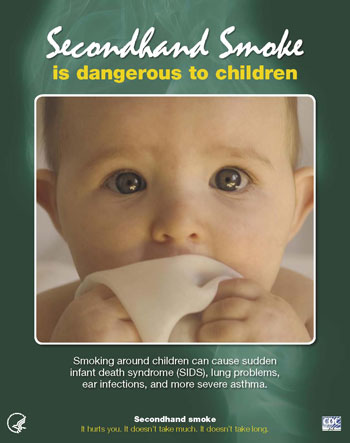Click to enlarge..
 December 12, 2010 - Epidemiologic studies have observed an association between secondhand smoke (SHS, passive smoking, second hand smoke, involuntary smoking, sidestream smoke) exposure and pediatric invasive bacterial disease (IBD) but the evidence has not been systematically reviewed.
December 12, 2010 - Epidemiologic studies have observed an association between secondhand smoke (SHS, passive smoking, second hand smoke, involuntary smoking, sidestream smoke) exposure and pediatric invasive bacterial disease (IBD) but the evidence has not been systematically reviewed.
Chien-Chang Lee of the Harvard School of Public Health in Boston reviewed other studies to find a clear dose relationship -- the more tobacco smoke children breathed in, the more likely they were to develop a serious infection.
PAPER: Association of Secondhand Smoke Exposure with Pediatric Invasive Bacterial Disease and Bacterial Carriage: A Systematic Review and Meta-analysis, Chien-Chang Lee1,2, Nicole A. Middaugh1, Stephen R. C. Howie3, Majid Ezzati4, published in the Public Library of Science journal PLoS Medicine, Abstract, Full Text, Editors' Summary..
Study found that children exposed to second-hand smoke were twice as likely to get serious infections called invasive meningococcal disease than children not exposed.
Children who breathed in smoke were also more likely to carry other bacteria such a Streptococcus pneumoniae, they found.
Chien-Chang Lee: When considered together with evidence from direct smoking and biological mechanisms, our systematic review and meta-analysis indicates that SHS exposure may be associated with invasive meningococcal disease. The epidemiologic evidence is currently insufficient to show an association between SHS and invasive Hib disease or pneumococcal disease. Because the burden of IBD is highest in developing countries where SHS is increasing, there is a need for high-quality studies to confirm these results, and for interventions to reduce exposure of children to SHS.
from Editor's Summary: Children are particularly vulnerable to the effects of SHS exposure (also known as passive smoking) because they are still developing physically. In addition, children have little control over their indoor environment and thus can be heavily exposed to SHS. Exposure to SHS increases the risk of ear infections, asthma, respiratory symptoms (coughing, sneezing, and breathlessness), and lung infections such as pneumonia and bronchitis in young children and the risk of sudden infant death syndrome during the first year of life.
Reference: in part Maggie Fox, Health and Science Editor Reuters, 12/7/2010..
Bringing the World of Tobacco Control closer together..
More tobacco smoke children breath in, the more likely they were to develop a serious infection..
Subscribe to:
Post Comments (Atom)


To Provide Public Awareness
Purpose
About Us
Contact Us
2008 HIGHLIGHTS
TOPIX PAPERS - 2008 & 2009..
Archive
-
▼
2010 (1530)
-
▼
12/12 - 12/19 (30)
- Germany - tobacco taxes to increase in May 2011..
- King County, Washington - bans the public use of ...
- Ireland - Office of Tobacco Control to be dissolv...
- Leduc, Alberta , Canada - bans smoking in cars wi...
- Altria Group Inc. - new senior management stru...
- Ukraine - draft law introduced to ban the sale ...
- Wisconsin - after smoking ban air quality in bars ...
- Massachusetts - Lorillard has to pay punitive dam...
- Changes in Cigarette Prices May Affect Alcohol Co...
- South Korean tobacco company KT&G signs deal to s...
- New York City - suing tobacco company in Washingt...
- BAT - number of regions in management structure re...
- Newport Non-Menthol - how's it doing?? - results ...
- December 16, 2010 - 2nd White House Tribal Nations...
- Thailand - TTM to build a new plant to produce c...
- England - smokers blocked from routine surgery as...
- Bulgaria - PMI to introduce their own Marlboro 10-...
- Canada - federal govt will be releasing new war...
- NIDA Report: 2010 "Monitoring the Future" marijua...
- Massachusetts - Lorillard loses lawsuit - did they...
- UK - Brits to petition govt to put a stop to adult...
- Fiji - new tobacco control decree will not come ...
- Massachusetts South Coast - smoking among pregnan...
- Quezon City, Philippines - will strictly enforce...
- FDA Law Blog - e-cigarettes, D.C. Circuit Court of...
- New Zealand - cigarette display ban passes first r...
- Study: 99% of Children Living in Apartments May Be...
- Hong Kong - latest survey - proportion of smoker...
- More tobacco smoke children breath in, the more li...
- Massachusetts - if states cover tobacco cessation...
-
▼
12/12 - 12/19 (30)
© Copyright Notice: The content of this website is for information education purposes only and any newsbrief may be used only as "fair use" for information/education purposes with permission of the authors and providing that original references and associated reference links are included in HTML format.
0 comments:
Post a Comment